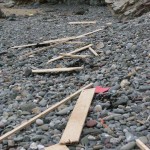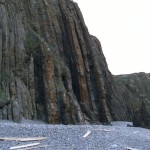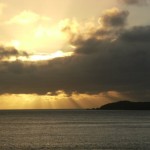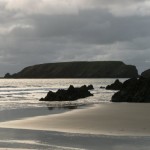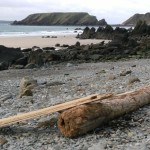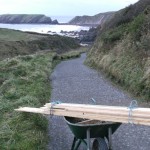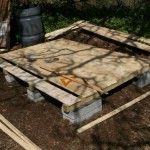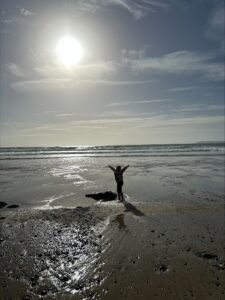Another gift from King Neptune
Pembrokeshire, with its three peninsulas (St. David’s, Dale and Castlemartin) jutting out into the Irish Sea, is at the receiving end of anything floating across the Atlantic Ocean drive by the Gulf Stream or North Atlantic Drift. The south-westerly winds, driving the great conveyor belt in the sea, deliver an astonishing variety of debris and fauna including sharks, dolphins, turtles, tropical trigger fish and crawfish. The rocky coasts have long been a grave yard for ships, even in todays modern times, especially in the early winter storms. On 28th October 1981 the tug Vernicos Alexia, formerly of Liverpool, was towing two sister tugs to Greece. She had engine problems off Pembrokeshire and fouled the tow cable. All three tugs were wrecked below the cliffs of the St. Davids Peninsula near Solva. In December 1922, the British E class submarine E39 (built in Jarrow in 1916) was being towed to shipbreakers when the tow broke and she came ashore into Milford Haven and broke in two. One half ended up near Watwick Beach and was blown up by a local diver to recover brass. The other half lies nearby in Mill Bay on the Dale Peninsula. On 14th March 1964 the boom defence vessel H.M.S. Barking was being towed to a breakers yard at Briton Ferry. The tow broke in heavy weather and she came ashore in Mill Bay, where she broke up over several years. From time to time the sands of Freshwater West on the end of the Castlemartin Peninsula move to reveal a sunken forest and also the large overturned bottom of the hull of the wooden three masted schooner Willemoes that was wrecked on the sands on 25th December 1924. She was built in 1911 and was on route from Caernarfon to Erquy in Britany. The wreck has a very fine sisal anchor cable of great thickness disappearing into the sand.
About every ten years some ship in the Irish Sea in a winter storm loses its deck cargo of wood. This timber comes ashore onto the west facing beaches of Pembrokeshire. The first winter storm of December 2012, brought the lastest gift from King Neptune. It was a deck cargo of sawn pine planks. The cargo had been broken up and the pieces arrived on all of the west-facing beaches of Pembrokeshire. At the time I was visiting my family in Kent where my wife works at the University of Kent. I then drove up to Edinburgh and visited our oldest son and his family. By the time I got back to Pembrokeshire the wood deck cargo had been on the beaches for two weeks. On any beach with a driving road nearby, the wood had disappeared, although the odd piece was still arriving. I searched around and found that some still remained on the southern end of Marloes Sands. It was there because pieces were still arriving after several weeks and because it required transporting the wood two miles, one along the beach to the footpath and the other up the footpath to the carpark. Happily in December the car park if free of charge
There was a problem of getting to and from the south end of Marloes Sands as at high tide the water reaches the sea cliffs and it is not possible to traverse the beach. So it was necessary to get to the beach at low tide. So I made a series of trips to the south end of the beach and took my wheel barrow with me to carry the wood for two miles. Happily in summer 2010, scenes for the film “Snow White and the Huntsman”, had been made on Marloes Sands, and the path to the beach had been improved by the film crews and horses by laying quarry dust on it. A good hard smooth surface resulted. High tide proved to be late at night and early in the morning. So my collecting trips proved interesting. At first I needed to leave the trips as late as possible. This meant getting to the south end of Marloes Sands just before it got dark (when the tide was sufficiently out). There had to be enough light left to select the wood as much was cracked and broken. Then I returned across the beach and back to the car in darkness. After a few trips, with the tide going out an hour later each day, I could no longer get to the wood in daylight. So I switched over to early morning trips. This meant getting to the south end of Marloes Sands in the dark and collect the wood at dawn and then returning to the car in daylight. The trips provided some wonderfully varied December sunsets and sunrises.
I did this until I had a fine collection of planks and wooden strips which have since been used to put in new floors in two old sheds, repair the sides of the sheds and make book shelves. The photographs accompanying this give a good idea of the work and there are several photographs of the very different skies and seas that were encountered at the time, typical of Pembrokeshire this in December.
